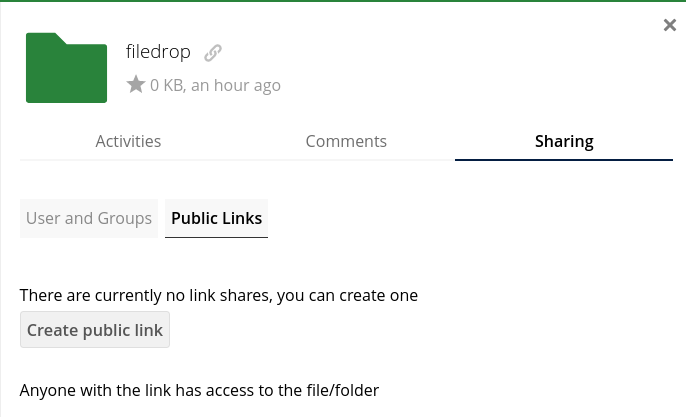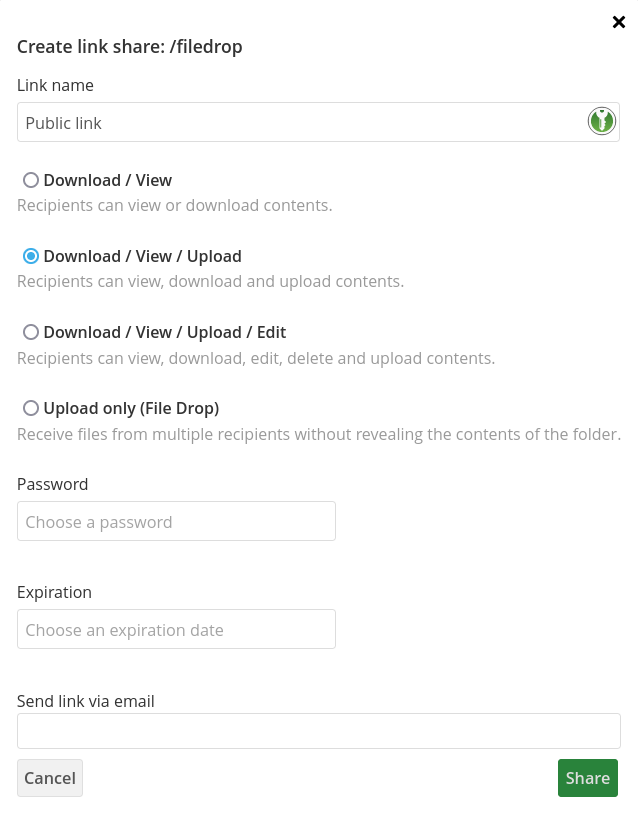This is the multi-page printable view of this section.
Click here to print.
Return to the regular view of this page.
Sharing
TSharing is an integral part of sciebo. Learn how to share files with your peers.
Instructions
- click the sharing symbol next to the folder that you intend to share:

-
Enter the search term into the text field that has appeared:
IMPORTANT:
If the user that you are trying to share with is not part of your institution the search term has to have the following format: SCIEBO_USERNAME@institution.sciebo.de.
Else the sciebo-username is sufficient. The sciebo-username already looks like an e-mail, for example
mmustermann@uni-muenster.de. Thus to find Max Mustermann, who studies at the University of Münster, the following search term has to be entered:
mmustermann@uni-muenster.de@uni-muenster.sciebo.de.
If the Person that you are looking for is part of the same institution as yourself, the searchterm can be a lot less complicated, for example you can usually find such a person with the search-term family name, first name.
-
Select the user from the list
If the user does not appear during the search:
Because there are a lot of users in a lot of institutions, the autocompletion-function of the search-bar sometimes does not work well. Because of this it may happen that a user does not appear during a search. To solve this problem, write the search-term (for example mmustermann@uni-muenster.de@uni-muenster.sciebo.de) in a text-file, and copy-paste it into the search-bar.
Another reason that the person does not appear might be that the person that you are trying to find is not yet registered to sciebo - the user must have logged into sciebo at least once.
1 - File Drops
Receive very large files from people who are not members of sciebo.
If you want to receive data from externals that is too big to be received by
email, you can create a so-called file drop. You just have to create a public
share and choose “Download / View / Upload” or “Download / View / Upload /
Edit” as permission. Choose “Upload only (File Drop)” if users shouldn’t be
allowed to see the content of the directory.
For internal use, a normal share between users can also be used and might be
more appropriate.
To do this, create a folder, e.g. “filedrop”.
In the context menue on the right side, under the tab “Sharing” you can now
create a public link:

Here you can set the permissions, and also a password and expiry date.

The expiry date is soft, i.e. the share does not vanish at 00:00, but it
usually takes a few hours until it is cleaned up.
2 - Groups
With sciebo you can create groups of users that you can share and edit files with.

If you often share data with the same group of people, you can create a group for this in the web interface. You no longer have to share data with each person individually, but can simply select the group you have created. All members of the group automatically get access to the data. You can set the editing rights as usual when sharing. Note, however, that groups can only consist of members of your own participant institution.
Creating Groups
- Log in to the sciebo web interface.
- Click on your name in the upper menu bar and then on “Settings”.
- Select “Custom Groups”.
- Enter a new group name in the text field and click on “Create group”.
- The member menu opens on the right.
- In the text field, enter the name of a person you want to add to the group, following the principle “last name, first name”. Select the person from the list that appears. He or she is now added to the group. Repeat the process for all other persons.
Managing Groups
To manage your groups, you must log in to the web interface. Click on your name in the top menu bar, then on “Settings” and select “Custom groups”.
Renaming a Group
- Move the mouse over the desired group. Click on the pencil symbol that appears next to its name.
- Change the name and confirm the change by pressing “Enter”.
Removing a Group
- Move the mouse over the desired group. Click on the bin symbol that appears.
- Click on “Yes” in the pop-up window to confirm the deletion.
Managing Group Members
To manage the members of one of your groups, you must log in to the web interface. Click on your name in the top menu bar, then on “Settings” and select “Custom groups”.
Adding Group Members
- Click on the group to which you want to add members. The members menu opens on the right.
- In the text field, enter the name of a person you want to add to the group, following the principle “last name, first name”. Select the person from the list that appears. He or she is now added to the group.
Please be aware that currently only users from the same instance can be added to a group.
Changing Group Roles
Group members can be either “group owner” or “member”. Group owners have all editing options for the group (including deleting, renaming, adding/removing members). There can be more than one owner. Members, on the other hand, cannot make any changes to the group. By default, only the person who created the group is the group owner. If you want to change the roles, proceed as follows:
- Click on the group whose member roles you want to change. The members menu opens on the right.
- In the list of group members you can see which member has which role.
- Move the mouse over the desired person. Click on the pencil symbol to change the role. (If you want to give up your role as group owner, you must confirm this, as you can no longer make any changes once you have given up the role).
Removing Group Members
- Click on the group from which you want to remove members. The members menu opens on the right.
- Move the mouse over the desired person. Click on the bin icon that now appears.
- Click on “Yes” in the pop-up window to confirm the deletion.
Sharing with a Group
In principle, you can share with a group in the same way as with individual users. Follow the appropriate instructions depending on the platform (web interface, client or app) via which you want to share. You only need to note the following differences:
- Instead of the person’s name, enter the group name when sharing.
- You can only set editing rights for the group as a whole and not for individual group members.
3 - Link Generator
Learn to share files and how to create shareable links. Regrettably, the link generator is not working at the moment.
When you share a folder or a folder is shared with you, that contains a lot
of subfolders, it is often annoying to navigate through the entire structure
or to explain to others how to get to a specific file. You can create a link that
leads to a specific folder that has been shared. This only works if the folder that
you shared is located in your root directory!
The link has the following form:
https://<institution of the person that you are sharing with>.sciebo.de/?dir=/<Path>/<to>/<the>/<directory>/
You can use the following tool to generate a link to a shared directory.
Share Link:
- In your browser, navigate to the directory that you want to share a link to.
- Copy the link from the address line of your browser into the field “File-URL”.
- Click “Apply”.
- Share the link to this page. The inputs you have provided will be persistent.
Follow Link:
You have received a link to this page.
- In the dropdown menu “Your Institution” select your institution.
- You can now follow the link in the field “Link to the File”.
Link Generator
File-URL
In the browser navigate to the folder that you want to share.
Copy the link from the adress line of the browser into this
field and click apply.
:
Link to this Page
This link leads to this link generator. Share this link with a person
that does not belong to your institution.
:
4 - Project Boxes
Project boxes are specialized sciebo accounts for work-groups that work with large amounds of data (30 GB to 2 TB).

Project boxes are special sciebo accounts for work groups that work with very large amounts of data (30 GB to 2 TB). They are particularly suitable for long-term projects with changing project management. Project boxes are not bound to individual persons, i.e. the role of the owner is transferable. Project boxes are managed in the owner’s my.sciebo section.
Click here for “HOW TO: Create and Manage Project Boxes”
Availability and Application Procedure
The institutions listed below provide project boxes. Unless otherwise noted, all employees with a sciebo account can apply for one.
Application via my.sciebo
- Deutsche Hochschule der Polizei
- Fernuni Hagen
- FH Dortmund
- FH Münster
- Folgwang-Uni Essen
- hbz NRW
- HS Bielefeld
- HS Bochum (professors only)
- HS für Gesundheit
- HS für Tanz und Musik Köln
- HS Hamm-Lippstadt
- HS Rhein-Waal
- Kunstakademie Düsseldorf
- Kunstakademie Münster
- Ruhr-Universität Bochum
- RWTH Aachen
- TH Köln
- TH Georg Agricola Bochum
- TU Dortmund
- Uni Bonn
- Uni Düsseldorf
- Uni Köln
- Uni Münster
- Uni Paderborn
- Uni Siegen
- Uni Wuppertal
Application to the IT Centre
- FZ Jülich: e-mail to IT representative/administrators
- RWTH Aachen: e-mail to IT orderers
- Uni Bielefeld: e-mail to service desk
Special Form
Application
The application should contain the following information:
- Applicant
- Project box name/identifier: 4 to 32 characters; e.g. Project-XY with the identifier project-xy.pbox@Your-Institution.de"
- Department/Organisational Unit
- Project description: In addition to a project title and a short abstract, information on the responsible organisational unit, project duration, project participants or funding may be useful. The text must not exceed 150 words.
- Storage volume: 30, 500, 1,000 or 2,000 GB
For all applications, the support of the institution decides on an approval. Once the application has been approved, you will be notified by e-mail.
Activation
In order to use the project box, you must first set the password:
- Log in to my.sciebo with your central user ID (not sciebo ID).
- Select the menu item “change project box password”.
- Select the desired project box from the drop-down list.
- Enter the new password.
- Log in to the sciebo web interface of your institution with the project box ID to activate the project box.
Usage
Direct access to the project box is only necessary for assigning access rights to the central project folder (using shares) and managing the associated editing rights:
- Log in to the sciebo web interface of your institution with the login data of the project box.
- Create a central project folder to be used for the project data.
- Share this folder with your own personal sciebo ID and the other project participants.
- You and the project participants can now access the shared project box folder via your/their own sciebo account(s) and create and edit folders and documents there.
Extension and Transfer
- Extension: The duration of a project box is 2 years. An extension is possible via my.sciebo.
- Transfer: The transfer of a project box is initiated via my.sciebo. (*Note: In order to enable the transfer to another person, no personal or copyright-protected data may be stored by the participants).




